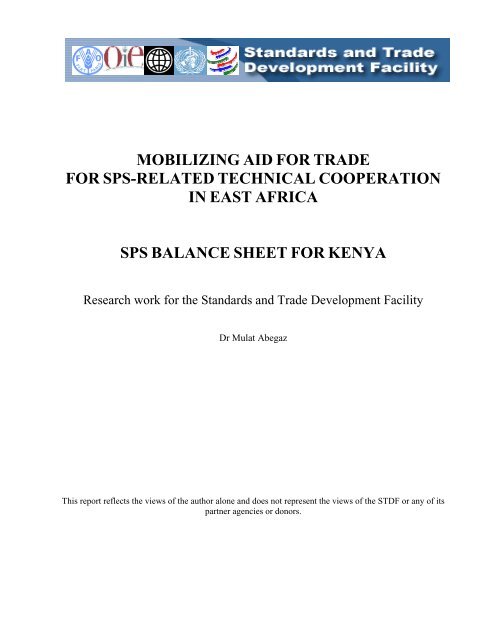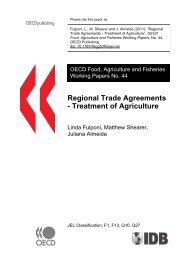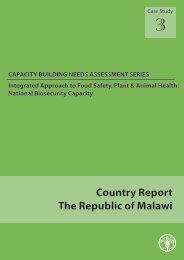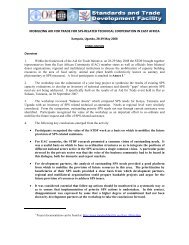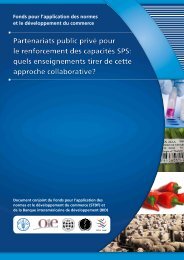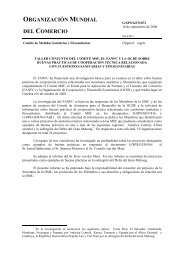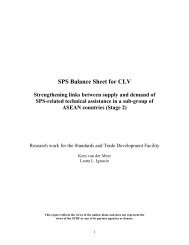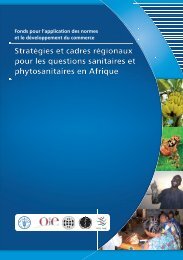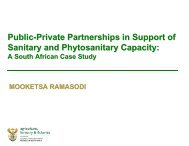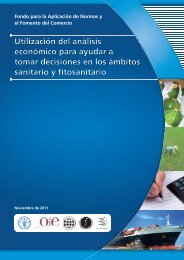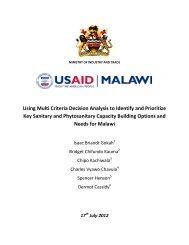Kenya - Standards and Trade Development Facility
Kenya - Standards and Trade Development Facility
Kenya - Standards and Trade Development Facility
You also want an ePaper? Increase the reach of your titles
YUMPU automatically turns print PDFs into web optimized ePapers that Google loves.
cover pageMOBILIZING AID FOR TRADEFOR SPS-RELATED TECHNICAL COOPERATIONIN EAST AFRICASPS BALANCE SHEET FOR KENYAResearch work for the <strong>St<strong>and</strong>ards</strong> <strong>and</strong> <strong>Trade</strong> <strong>Development</strong> <strong>Facility</strong>Dr Mulat AbegazThis report reflects the views of the author alone <strong>and</strong> does not represent the views of the STDF or any of itspartner agencies or donors.
1. Introduction1. The objective of this STDF research work is to further strengthen the linkage between "supply" <strong>and</strong>"dem<strong>and</strong>" of technical cooperation in the area of food safety, animal <strong>and</strong> plant health (collectively known assanitary <strong>and</strong> phytosanitary or SPS) requirements. As such, this research is being carried out in the frameworkof the broader Aid for <strong>Trade</strong> Initiative. The work builds on existing capacity assessments in the SPS area ofcapacity evaluation tools developed <strong>and</strong> applied by international organizations such as the Food <strong>and</strong>Agriculture Organization (FAO) <strong>and</strong> the World Bank, as well as other studies <strong>and</strong> reports. It is not a newcapacity evaluation, but rather an attempt to consolidate the results of previous studies.2. This report presents a balance sheet of needs <strong>and</strong> supplies in the SPS area for <strong>Kenya</strong>. Similar balancesheets have been developed for Tanzania <strong>and</strong> Ug<strong>and</strong>a, as well as at a regional level. The aim of the report isto strengthen the supply <strong>and</strong> dem<strong>and</strong> for SPS-related technical cooperation by:• acting as a focus for information sharing of needs evaluations <strong>and</strong> ongoing <strong>and</strong> planned activities;<strong>and</strong>• identifying gaps where they exist <strong>and</strong> further mobilizing the provision of capacity building resourcesas necessary.2. Overview of priority action areas3. The Investment Programme for the Economic Recovery Strategy (IP-ERS) for Wealth <strong>and</strong>Employment Creation 2003-2007 (in the process of being replaced by "Vision 2030") <strong>and</strong> the NationalExport Strategy Implementation Action Plan 2005-2008 set out <strong>Kenya</strong>’s economic growth <strong>and</strong> povertyreduction targets. Although the new government can be expected to update these strategy documents, themain constraints faced remain the same. <strong>Kenya</strong>’s agriculture <strong>and</strong> food processing sector has a key to play inachieving poverty reduction <strong>and</strong> economic growth targets. Within this sector, a range of SPS issues act as abrake on productivity, impede access to potential markets <strong>and</strong> impose losses on the economy as a result of theburden of food-borne illness. The Strategy for Revitalizing Agriculture (SRA, 2004) aims to make <strong>Kenya</strong>'sproducts more competitive on international markets <strong>and</strong> improve producers' incomes.4. <strong>Kenya</strong> has several “flagship” agro-industries which are successful models of export-led growth, inparticular cut flowers, fresh vegetables, tea <strong>and</strong> fish. Within these success story sectors, SPS issues act as abrake on further growth <strong>and</strong> impose important control costs. A range of plant pests <strong>and</strong> diseases reduce fruit<strong>and</strong> vegetable production <strong>and</strong> the possibility of extending the successful model of small-holder supply chainsinto new product groups <strong>and</strong> growing areas. Ever more stringent food safety rules in key export markets withrespect to residues of agro-chemicals <strong>and</strong> microbiological contamination require constant commercialvigilance, proactive regulatory action <strong>and</strong> effective research capacity to develop <strong>and</strong> deploy alternate controlmethods to maintain export volumes. Process based private st<strong>and</strong>ards designed to minimize food safety risksare being extended into environmental <strong>and</strong> social issues. A further challenge, although also not SPS-specific,is that posed by environment campaigners in certain key markets with regard the impact of air transport onclimate change.5. The lake fisheries sector is an example of where SPS issues have closed down a key export market.Fortunately, the sector is also an example of how these constraints have been successfully overcome. In thewake of export restrictions to the EU market in the late 1990s, <strong>Kenya</strong> upgraded compliance capacity in thelake fisheries sector, with assistance from a variety of donors, <strong>and</strong> reduced its dependence on the EU marketby accessing new markets including Israel, Singapore, Japan <strong>and</strong> Australia. The last EU Food <strong>and</strong> VeterinaryOffice (FVO) inspection in 2006 noted excellent performance by the competent authority. However, SPScompliance is a process of continuous improvement. Thus, whilst noting the excellent performance with2
espect to enforcement of local st<strong>and</strong>ards, the FVO still raised a number of concerns in relation to sanitarycontrols, in particular in relation to their equivalence with EU legislation in areas such as the ability to test forhistamine <strong>and</strong> heavy metals.6. SPS issues remain an absolute block for access to many markets for the livestock sector, a drain onproductivity <strong>and</strong> threat to livelihoods for small farmers. The continued prevalence of important animaldiseases for livestock trade, weak veterinary infrastructure, facilities <strong>and</strong> services, low rates of investment inslaughterhouses, meat processing <strong>and</strong> distribution services mean that <strong>Kenya</strong>’s meat export opportunities arelimited to intra-regional trade, mainly in live animals. The on-going efforts of the <strong>Kenya</strong>n Government,Department of Veterinary Service, the Dairy Board <strong>and</strong> private sector to improve the animal health situation<strong>and</strong> to support the sector in line with international st<strong>and</strong>ards need to be further supported.7. The decline in coffee exports, one of <strong>Kenya</strong>’s major traditional cash crops, has been exacerbated bypest <strong>and</strong> disease problems. A main export earner <strong>and</strong> a means of livelihood to several hundred thous<strong>and</strong>people, the sector has contracted by half during the last 20 years. Factors attributed to the decline are mainlyrelated to commodity price decline, competition in the world coffee market, inefficiency in marketarrangements <strong>and</strong> other issues. Against this background of economic downturn, the ability to control pests,diseases <strong>and</strong> weeds has also declined, so exacerbated the production downturn.8. Food-borne diseases remain a problem in <strong>Kenya</strong>. Up to 70% of all episodes of diarrhoea may beattributed to ingestion of contaminated food <strong>and</strong> water. The most prevalent diseases in the year 2004 weretyphoid dysentery <strong>and</strong> gastroenteritis, which affected 643,151, 600,660, <strong>and</strong> 722,275 people respectively.Others include aflatoxin poisoning (323), brucellosis (198) <strong>and</strong> cholera (68). Some of these are seasonal <strong>and</strong>require adequate planning for preventive response. For example, aflatoxin poisoning prevalence peaks duringfood shortages <strong>and</strong> rainy seasons preceded by drought conditions within specific regions, while typhoid peaksmainly during the rainy seasons. In addition, available statistics are not well documented <strong>and</strong> processed foruse in decision-making. Investigations into causative factors <strong>and</strong> magnitudes of exposure to trigger theirmanagement are inadequate <strong>and</strong> require strengthening.9. The burden of food-borne disease also creates a difficulty in the service sector, in particular for thetourism trade. The tourist sector’s backward linkages related to the supply of safe food, hygiene <strong>and</strong>sanitation issues need to be properly addressed. For income from visitors to be maximized <strong>and</strong> the likelihoodof return visits increased, food-borne risks need to be reduced.10. <strong>Kenya</strong>’s successful penetration of the EU market, in particular for cut flowers <strong>and</strong> fresh vegetables,can mask its equal success in exp<strong>and</strong>ing south-south trade. A growing range of primary <strong>and</strong> value-addedproducts is going to the East African Community (EAC), the Common Market of East <strong>and</strong> Southern Africa(COMESA), the Middle East, Asia, Russia, Israel <strong>and</strong> other markets. In particular, <strong>Kenya</strong> has takenadvantage of the improved trading opportunities afforded by the East African Customs Union <strong>and</strong> COMESA.Continued diversification both in the range of products traded <strong>and</strong> markets need to be further strengthened.Key in this respect is supporting the private sector associations which have been so prominent in driving thesuccess development of their sectors (horticulture, fish, tea, etc.) <strong>and</strong> pushing for a supportive governmentpolicy environment.11. Based on existing capacity assessments <strong>and</strong> evaluations, the following priority areas emerge as notbeing currently addressed by the existing or planned donor programmes. Addressing these areas would helppoverty alleviation by reducing the burden of animal disease <strong>and</strong> plant pests so increasing small farmerincome, generate additional export revenue, <strong>and</strong> reduce the burden of food-borne disease in the population<strong>and</strong> on the economy.• Tackle pest problems limiting expansion in the floriculture <strong>and</strong> horticulture sectors, in particular dueto fruit fly, exp<strong>and</strong> small-holder certification schemes into new production areas <strong>and</strong> product groups,3
<strong>and</strong> strengthen the public infrastructure underpinning both sectors, both physical (e.g. throughlaboratory accreditation to international st<strong>and</strong>ards) <strong>and</strong> soft (i.e. through continued training in suchareas as pest risk analysis);• Address disease problems limiting the export of livestock, meat <strong>and</strong> dairy products through a focusedprogramme of investment <strong>and</strong> strengthen the performance of <strong>Kenya</strong>’s veterinary servicesConsideration should be given to different possible methods for the development of greater meatprocessing capacity, e.g. through disease free zones, compartments or a commodity-based approach;• Maintain SPS compliance capacity in the lake fisheries sector through continued investment <strong>and</strong>training in the public <strong>and</strong> private sector. The scope for further development of the sector in coastalfisheries <strong>and</strong> through aquaculture, <strong>and</strong> associated SPS risks, should be assessed;• Offer training for trade associations on SPS compliance strategies relevant to their membercompanies <strong>and</strong> encourage their efforts to obtain proactive government services in support of theirsectoral needs. An important part of market access is related to SPS diplomacy <strong>and</strong> a closerelationship between government <strong>and</strong> the private sector when it comes to monitoring <strong>and</strong> reacting tochanges in the SPS measures of trading partners. SPS is an area of continual improvement <strong>and</strong> suchcapacity needs to be sustained for the long term;• Update existing regulatory <strong>and</strong> institutional frameworks with the establishment of generic SPS/foodlaws <strong>and</strong> umbrella regulations. A particular need is to push for the adoption of the draft “NationalFood <strong>and</strong> Nutrition Policy” <strong>and</strong> proposed “National Food Safety Focal Point” involving all keyrelevant stakeholders which will promote integration of SPS issues into planning <strong>and</strong> budgetaryframeworks so raising the profile of SPS issues nationally;• Provide food safety training in the tourism sector <strong>and</strong> examine ways to integrate local suppliers intohotel supply chains, as part of a comprehensive evaluation of food safety needs;3. Overview of ongoing <strong>and</strong> planned donor assistance12. The <strong>Kenya</strong> Joint Assistance Strategy (KJAS, 2007-2011) <strong>and</strong> Partnership Principles agreed with theGovernment of <strong>Kenya</strong> specify the ways in which donors support efforts to economic growth <strong>and</strong> povertyreduction. Donors in <strong>Kenya</strong> are organized in the Harmonization, Alignment <strong>and</strong> Coordination (HAC) group 1 .There are also sector <strong>and</strong> thematic working groups to coordinate support to sectors <strong>and</strong> subsectors13. Unlike Tanzania <strong>and</strong> Ug<strong>and</strong>a, general budget support is limited <strong>and</strong> currently only provided by theEuropean Union. Specific sector budget support is increasingly being used <strong>and</strong> efforts could be made fortrade <strong>and</strong> SPS capacity building to figure more prominently in existing basket programmes, focusing forinstance on agriculture, private sector development, etc. Finally, it is observed that donor support for specificproject <strong>and</strong> programmes, whether at national, regional, ACP or all developing country level will continue in2008 <strong>and</strong> beyond. From the overview of on-going <strong>and</strong> future planned donor programmes (Annex I) it seemsthat there are significant opportunities to fund outst<strong>and</strong>ing SPS needs <strong>and</strong> priorities beyond 2008.1 As of January 2007, members include Canada, Denmark, Finl<strong>and</strong>, France, Germany, Italy, the Netherl<strong>and</strong>s, Norway,Spain, Sweden, the United Kingdom, the United States, the African <strong>Development</strong> Bank, the European Commission, theUnited Nations, <strong>and</strong> the World Bank Group. China <strong>and</strong> Malaysia are recent entrants in the donor arena <strong>and</strong> are as yet notparticipants in the HAC.4
Products/markets SPS compliance constraints Ongoing <strong>and</strong> plannedassistanceFish <strong>and</strong> fishery productsFish sourced from inl<strong>and</strong> <strong>and</strong> coastalfisheries, <strong>and</strong> aquaculture. Sectorestimated to employ about 300,000people directly or indirectly (2004).Total production (2005) is 140,000MT (90% from Lake Victoria).Major commercial fresh waterspecies include Nile perch (to EU<strong>and</strong> other markets e.g. Israel,Singapore, Japan <strong>and</strong> Australia),tilapia (mainly local consumption<strong>and</strong> emerging regional market) <strong>and</strong>omena (local consumption/feed).Marine products include prawns,octopus, tuna, sardines, lobster <strong>and</strong>crab.Fisheries sector recovered after EUtrade restrictions on exports of Nileperch in 1990s. Processors organizedin Association of Fish Processors<strong>Kenya</strong> (AFIPEK) <strong>and</strong> MoU betweenAFIPEK <strong>and</strong> Fisheries Department inplace.Current concerns over sustainabilityof sector in Lake Victoria (decliningcatch, increased wastage at l<strong>and</strong>beaches, poor fishing methods).Inl<strong>and</strong> fisheries sector going throughprocess of rationalization (facilitiesoperating at low capacity). Relativelylesser attention has been given todevelopment of fisheries in LakeTurkana, coastal fisheries <strong>and</strong>aquaculture.In 2006, EU Food <strong>and</strong> VeterinaryOffice (FVO) inspection noted goodperformance of official controlactivities. It also reported followingdeficiencies:- Lack of equivalent regulations <strong>and</strong>st<strong>and</strong>ards to newly established EUst<strong>and</strong>ards <strong>and</strong> regulations;- Deficient conditions in somel<strong>and</strong>ing sites <strong>and</strong> fishing vessels- Deficiencies in designatedlaboratory for pesticide residues;- Lack of analysis of histamine <strong>and</strong>heavy metals.The recently adopted FishRegulations (2007) lack st<strong>and</strong>ardoperating procedures (SOPs),guidelines <strong>and</strong> manuals for freshwater, marine <strong>and</strong> aquaculturefisheries. Training to enforce <strong>and</strong>implement new Fish Regulations isneeded. Government is consideringestablishment of modern auctioncentre in Kisumu - for which fundingis lacking.Other main issue relates to lack ofknowledge of fisheries of modernfishing <strong>and</strong> h<strong>and</strong>ling techniques(including use of ice). Awarenessraising <strong>and</strong> training activities arebeing conducted by FisheriesDepartment <strong>and</strong> beach officers butneed to be multiplied.Following the EC bans, supportwas offered by several donorsincluding FAO, AfDB, UNIDO,EC <strong>and</strong> World Bank.Specific ongoing <strong>and</strong> plannedactivities identified include:- EC - Implementation ofFisheries Management Plan forLake Victoria (ending in 2008apart from upgrading severall<strong>and</strong>ing sites).- EC/Indian Ocean TunaCommission - Indian OceanTagging Project (2004-2009).- EC (Strengthening FisheryProduct Health Conditions inACP countries (SFP, extendeduntil 2010).- EC/IOC Secretariat – RegionalSustainable Management ofCoastal Resources (2005-2010);- EC - 10 th EDF (2008-2013,with focus on capacity buildingfor fishery organizations on foodsafety issues, including SPS).Recommended actions/gapsThe following actions arerecommended (in line with FVO <strong>and</strong>other reports):- Strengthen inspection <strong>and</strong> train staffin performing official controls in linewith the newly established EUregulations.- Develop manuals, guidelines <strong>and</strong> thenecessary SOPs in line with new FishRegulations.- Continue education of fisheries onfishing <strong>and</strong> h<strong>and</strong>ling techniques(including use of ice).- Designate competent pesticidelaboratories <strong>and</strong> strengthen analyticalcapacity for histamine <strong>and</strong> heavy metal.- Upgrade remaining l<strong>and</strong>ing sites.-Attract funds for establishment ofauction market with basic facilities forat least four beaches to improve qualitycontrol <strong>and</strong> marketing;- Continue assistance to industryassociations training membercompanies on HACCP/ISO 22000 <strong>and</strong>consolidate associations' code ofpractice.- St<strong>and</strong>ardize fish drying <strong>and</strong> smokingpractices (trade to DRC, Rw<strong>and</strong>a <strong>and</strong>Burundi).- Conduct feasibility study to explorepotential of aquaculture <strong>and</strong> marinefisheries - including SPS requirements -<strong>and</strong> develop policy package <strong>and</strong>guidelines to attract investment.- Conduct study to determine capacity<strong>and</strong> extent of parasite problem in LakeTurkana.Priority11111122336
Products/markets SPS compliance constraints Ongoing <strong>and</strong> plannedassistanceLivestock <strong>and</strong> poultry products<strong>Kenya</strong> has a large cattle herd (13.5m<strong>Kenya</strong> has benefited fromheads) but meat exports constitutesupport from regional <strong>and</strong>less than 1% of total exports (<strong>and</strong>national projects implementedhave been declining since 1990).by inter alia the EC (e.g. Pan-Livestock is used predominantly forAfrican Program for the Controlsupporting subsistence of ruralof Epizootics), FAO <strong>and</strong> IFAD.households. Annual production(2003) estimated at about 363,000Specific ongoing <strong>and</strong> plannedMT (beef) <strong>and</strong> 16,000 MT (pork).activities identified include:Most important destination for meatexports is EAC region followed byEritrea, Bahrain <strong>and</strong> the UAE.Consultations with Middle Eastcountries <strong>and</strong> Egypt ongoing. <strong>Trade</strong>in live animals takes place mainly oninformal basis, bringing cattle fromneighboring countries into <strong>Kenya</strong>through its “porous” frontiers.Beef production mainly found in arid<strong>and</strong> semi arid l<strong>and</strong>s (ASALs).Shortcomings exist in sanitarycontrols at slaughterhouses <strong>and</strong> meatprocessing plants. Some canneriesrehabilitated <strong>and</strong> reopened in 2006.<strong>Kenya</strong> Meat Commission hasmanufacturing facility (but shelvedits regulatory function for now).Poultry population estimated at about30 million birds. Annual poultryproduction estimated at 19,000 MT.Five main hatcheries produce over 16million day-old chicks annually. Noinformation available on trade inwild animals or by- products such ashides <strong>and</strong> skins.There are opportunities for targetingexports that will cater to deficits inregional consumption of livestockproducts. However, a series of SPSconstraints have to be overcome:- animal health status <strong>and</strong> diseasemanagement (presence of severalendemic animal diseases, illustratedby several trade bans, most recentlydue to Rift Valley Fever in 2007).-absence of monitoring system todocument diseases <strong>and</strong> actions toeradicate them.- poor hygienic conditions inslaughterhouses, h<strong>and</strong>ling <strong>and</strong>processing facilities (lack of GHP,GMP <strong>and</strong> HACCP application), <strong>and</strong>lack of inspection <strong>and</strong> enforcement.- absence of control <strong>and</strong> low qualityof animal feed.Other constraints are related totransportation (i.e. animals should beslaughtered closer to breedinglocations), lack of investment <strong>and</strong>revamping meat distribution systems(especially informal channels).Directorate of Veterinary Services(DVS) is currently establishingdisease free zones, engagingcommunities through sensitization<strong>and</strong> education to actively participatein disease reporting <strong>and</strong> livestockmovement control, <strong>and</strong> involved inanimal disease surveillanceespecially at borders. These activitiesneed further support.- USAID/USDA – PASA projectsto conduct animal disease riskassessments (not yet started).- EC/AU-IBAR: SupportProgramme to IntegratedNational Action Plans forAvian <strong>and</strong> Human Influenza(SPINAP-AHI).- World Bank Group: Promotinglong term investment inlivestock in <strong>Kenya</strong>..Recommended actions/gaps<strong>Kenya</strong>'s prime SPS constraint is itsanimal health status followed bysanitary concerns. Actions to addressdisease situation depend greatly oncapability of DVS. Results of OIE PVStool (applied in 2006 but not in publicdomain) should be used to identifyactions to strengthen DVS. Increasingrole of private sector should beconsidered in rural areas <strong>and</strong> publicprivateinvestment should be promoted.Some key actions identified in variousother studies include:- strengthening animal health <strong>and</strong>disease control monitoring, inspection<strong>and</strong> surveillance activities;- training inspectors <strong>and</strong> veterinarypersonnel.- further strengthening efforts of meatindustries (striving to export fresh <strong>and</strong>frozen <strong>and</strong> canned products to region<strong>and</strong> Middle East) through marketresearch, business development <strong>and</strong>technical assistance on food safety(GHP, GMP <strong>and</strong> HACCP) <strong>and</strong> meattechnologies.- enhancing animal feed situation.- continuing establishment of diseasefree zones <strong>and</strong> engagement ofcommunities through awareness raisingactivities.- introducing mobile screening units (2-3 at major markets) for CBBP (staffalready trained to operate devices).- strengthening analytical capacities ofDVS <strong>and</strong> university laboratories(including drug residue analysis).Priority11221127
Products/markets SPS compliance constraints Ongoing <strong>and</strong> plannedassistanceDairy productsDairy industry is predominantlySpecific & ongoing assistancesmall-holder based in ASALs.include:Annual production is now estimatedto be 4 billion liter (of which 3.5USAID: Regional Agriculturebillion is for local consumption. Past<strong>Trade</strong> Expansion Supportemphasis was mostly on increasing(RATES) including COMESAproduction, but recently efforts areDairy SPS protocol.made to improve quality.Vending of raw milk throughinformal markets accounts for some80% of total sales. Poor hygienicpractices in milk collection <strong>and</strong>h<strong>and</strong>ling are reported. Presence ofanti-microbial residues is main publichealth concern <strong>and</strong> poses exportconstraints. There are about 26 dairyplants, 10 of which have capacitiesmore than 10,000 l/day.Industry is comparatively moredeveloped than dairy industries ofmany other countries in sub-SaharanAfrica. Dairy products are mainlyexported to EAC countries <strong>and</strong> thereare limited opportunities to enhancethis trade. Potential markets includeMiddle East, North <strong>and</strong> Sub-SaharanAfricaMinistry of Livestock <strong>and</strong> Fisheries<strong>Development</strong> (MLFD) through<strong>Kenya</strong> Dairy Board (KDB) isresponsible for monitoring quality<strong>and</strong> safety, inspection, establishmentor milk receiving centers, <strong>and</strong>awareness-raising <strong>and</strong> training.Among key constraints are poorhygienic practices in milk h<strong>and</strong>ling<strong>and</strong> poor milk collection, transportmethods, lack of inspection <strong>and</strong>surveillance, outdated legislation -but also more fundamental problemsrelated to livestock management,disease control <strong>and</strong> treatment <strong>and</strong>animal feed practices (see above). ACode of Hygienic Practice forproduction, h<strong>and</strong>ling <strong>and</strong> distributionof milk <strong>and</strong> milk products exists butcannot support production <strong>and</strong>h<strong>and</strong>ling processes in unregulatedmarkets.In milk processing industry concernsare related to product <strong>and</strong> marketdevelopment , production efficiency<strong>and</strong> competitiveness, investment <strong>and</strong>export promotion (where food safetyst<strong>and</strong>ards are likely to become animportant issue). Studies show thatlarge scale farmers are morecompetitive producers. Withreduction in domestic costs(transport, packaging, etc.), <strong>Kenya</strong>could become globally competitive.Recommended actions/gapsThe following actions arerecommended to enhance domesticmilk production <strong>and</strong> prospects forexports:- continue <strong>and</strong> enhance awarenessraising,extension <strong>and</strong> training activitieson application of good hygienicpractices.- strengthen DVS capacity formonitoring, surveillance <strong>and</strong> control ofanimal diseases.- finalize <strong>and</strong> enact new Dairy Act inline with dairy development strategy<strong>and</strong> international requirements(supported by SOPs <strong>and</strong> guidelines.- enhance awareness-raising activitiesat consumer level (creating pressure onsuppliers).- control of antimicrobials throughdevelopment of national frameworkprogram (including augmentinglivestock development <strong>and</strong>management practices in both formal<strong>and</strong> informal livestock supply chains,e.g. disease management, inadequacyof animal feed, inadequate access toanimal health services in rural areas,breeding programmes, etc.).- strengthen analytical capacity formonitoring of veterinary drugs <strong>and</strong>aflatoxin level in dairy products.- further assist industries inimplementation of GMP, GHP <strong>and</strong>HACCP.Priority11122228
Products/markets SPS compliance constraints Ongoing <strong>and</strong> plannedassistanceTraditional commodities<strong>Kenya</strong>’s traditional cash crops Major constraints in coffee export are(coffee <strong>and</strong> tea) provide a livelihood mainly non-SPS factors includingfor more than 750,000 <strong>and</strong> small price decline, competition from Latingrowers <strong>and</strong> plantation employees. America <strong>and</strong> Asia, <strong>and</strong> countryCoffee exports declined over past specific conditions attributed totwo decades from about US$320m policy environment, government(1985) to US$110m (2004), while tea interventions, <strong>and</strong> inefficiency ofexports exp<strong>and</strong>ed from US$300m to cooperatives.US$400m during the same period.<strong>Kenya</strong> is the second largest teaexporter world-wide (after SriLanka).Coffee Board of <strong>Kenya</strong> <strong>and</strong> <strong>Kenya</strong>Tea <strong>Development</strong> Agency areresponsible for regulatory <strong>and</strong>marketing functions of coffee <strong>and</strong>tea, respectively.Strategies to target niche <strong>and</strong> highervalue markets, like specialty <strong>and</strong>organic products, have grown inimportance.At present, no specific SPSconstraints reported but problemsrelated to pesticides (anticipatingstricter MRLs) <strong>and</strong> fumigationpractices <strong>and</strong> mycotoxins resultingfrom h<strong>and</strong>ling <strong>and</strong> storage practicescould be serious challenges in nearfuture. Pre-emptive actions arerecommended.Various donors have providedgeneral agricultural support orsupport related to upgrading thequality of specific commoditiesin the past.Specific ongoing <strong>and</strong> plannedactivities include a projectfunded by the Bill <strong>and</strong> MelindaGates Foundation to supportsmall-scale coffee farmers inEast Africa.Recommended actions/gapsThe market for traditional commoditiesis increasingly dominated by privatest<strong>and</strong>ards with non-SPS elements e.g.fair trade, organic, private labelsincluding environmental <strong>and</strong> socialaspects.. Besides investigating furtheropportunities for organic produce <strong>and</strong>br<strong>and</strong>ing of coffee <strong>and</strong> tea, furtherpromotion of basic/good practices(h<strong>and</strong>ling, drying, etc.) <strong>and</strong> training tosmall-scale producers is recommended.Continue monitoring MRLs <strong>and</strong>myctoxins in tea <strong>and</strong> coffee in line withCodex st<strong>and</strong>ards <strong>and</strong> requirements oftarget export market countries (EU,USA, Japan, etc.).Priority219
Products/markets SPS compliance constraints Ongoing <strong>and</strong> plannedassistanceTourismTourism is the main service export,In the past, several donoran important source of foreigninitiatives have supported theexchange earnings (estimated attourism sector.US$340m in 2004), <strong>and</strong> providesdirect employment for some 210,000employees, <strong>and</strong> for a further 280,000people employed in support sectors.Tourism's backward linkages arespread through many sectorsincluding inter alia horticulture(fruits <strong>and</strong> vegetables), livestock(meat <strong>and</strong> dairy products), poultry(meat <strong>and</strong> eggs) <strong>and</strong> fisheries (fish<strong>and</strong> seafood).Reportedly, a separate World Bankstudy on tourism sector is underway.Compared with other countries inSub-Saharan Africa, industry hasgrown below average. Mainconstraints are security situation(highlighted by recent conflictsfollowing election in 2007), poorroad infrastructure, deterioration oftourism infrastructure <strong>and</strong> services,weak institutional <strong>and</strong> regulatoryframework to promote furtherinvestment, <strong>and</strong> insufficientmarketing <strong>and</strong> promotion efforts.SPS-related constraints include lackof awareness of food safety risks intourist industry, training in goodhygiene practices, inadequatesurveillance/monitoring system, <strong>and</strong>weak inspectorate capacities.Recommended actions/gaps- Strengthen awareness <strong>and</strong> trainingprogrammes for tourism industry onfood safety risks, good hygienepractices, etc.- Strengthen surveillance/ monitoringsystem including inspectoratecapacities.Priority1210
5. Food safetyStatus Needs Ongoing <strong>and</strong> plannedassistanceAwareness- Limited awareness about impact of - Review draft NFNP by food safety FAO/WHO programmesfood safety on national economy <strong>and</strong> <strong>and</strong> quality experts to clearly guidedevelopment at all levels, with implementation schemes of foodnotable exception of fisheries <strong>and</strong> safety <strong>and</strong> food control system,horticulture export industry (no followed by its adoption <strong>and</strong>effective foodborne disease reporting incorporation into nationalsystem in place).development plans.- Limited resources <strong>and</strong> budget - Increase awareness about thesupport for institutions involved in impact of food safety <strong>and</strong> quality onfood safety <strong>and</strong> quality control. the economic <strong>and</strong> social fabric of the- No policy on food safety control nation among top decision-making(draft National Food <strong>and</strong> Nutrition levels.Policy (NFNP) does not refer to - Enhance information, education <strong>and</strong>enhancement, restructuring or training programmes at all stages <strong>and</strong>modernization of food control for all stakeholders in food chain,system.including farmers, universities,- Several universities have food research institutes, consumers, etc.science <strong>and</strong> technology departments<strong>and</strong> curricula.- Several institutes <strong>and</strong> associationsinvolved in awareness-raising <strong>and</strong>training programmes for smallholders,exporters, producers <strong>and</strong>consumers including HCDA,FPEAK, AFIPEK, KEPHIS, KDB,CIN, EPC.Institutional <strong>and</strong> regulatory framework- Lack of efficient coordination/collaboration among multiple keyfood safety <strong>and</strong> quality controlinstitutions.. 2- Develop ToR of recently proposed(rotating) National Food Safety FocalPoint <strong>and</strong> make reference to roles <strong>and</strong>m<strong>and</strong>ates of participating institutionsFuture donor programmes focusincreasingly on private sector<strong>and</strong> business development - butrelatively less on public sectorcapacity building.Several donor programmes inplace includingschemes/facilities for upgradingfood safety/quality in small <strong>and</strong>medium enterprises (SMEs)through training, loans, partialsubsidies, etc. (see Annex I).Other relevant existing <strong>and</strong>planned projects include:- UNIDO – regional EACproject.- EC - Capacity Building onMaximum Residue Levels(MRLs) (2006-2010).- EC - Strengthening FoodSafety Systems throughsanitary <strong>and</strong> phytosanitary(SPS) measures (ACP, 2008 –2012).- EC - Strengthening FisheryProducts Health Conditions inACP countries (SFP, extendeduntil 2010);Recommended actions/gaps- Develop national policy statement,review draft NFNP, integrate foodsafety into national development plans<strong>and</strong> organize symposium for politicians<strong>and</strong> senior decision-makers.- Coordinate <strong>and</strong> strengthen ongoingefforts <strong>and</strong> training programmes onGMP <strong>and</strong> GHP (smaller processors <strong>and</strong>street vendors) <strong>and</strong> HACCP (larger <strong>and</strong>medium-sized processor) conducted bydifferent institutions <strong>and</strong> associations.- Create public consumer protectionoffice <strong>and</strong> further strengthen consumerassociations.- Determine the appropriate policymixture for the private <strong>and</strong> publicprovision of laboratory infrastructure.- Establish the proposed National FoodSafety Focal Point to coordinates foodsafety <strong>and</strong> quality control issues;- Preparation of new umbrella food actPriority1121111
Status Needs Ongoing <strong>and</strong> plannedassistance- Legislation related to food control related to food safety <strong>and</strong> quality.system - including implementing - Legislation needs revision startingregulations - outdated <strong>and</strong> in need of with umbrella basic food act -revision. Exception are the Fisheries followed by range of sectoral(Safety of Fish, Fishery Products <strong>and</strong> legislation <strong>and</strong> regulations on meat,Fish Feed) Regulations (2007), dairy products, feed, etc. Reportedly,which have been recognized as Ministry of Livsetock <strong>and</strong> Fisheriesequivalent to EU regulations by FVO <strong>Development</strong> (MLFD) has startedin 2006. 3process of reviewing sectorallegislation.Enforcement- Food inspection is responsibility ofMoH (Public Heath Department),employing about 8,000 inspectors.Inspection also by local governmentauthorities <strong>and</strong> by various sectoralinstitutions <strong>and</strong> boards. FisheriesDepartment does not oversee localfish <strong>and</strong> seafood h<strong>and</strong>ling (similar inTanzania <strong>and</strong> Ug<strong>and</strong>a). Both MoH<strong>and</strong> DVS inspect abattoirs <strong>and</strong>slaughterhouses.- Limited monitoring of pesticide <strong>and</strong>veterinary drug residues, notably inlocal markets. FPEAK monitorspesticide residues <strong>and</strong> microbialcontaminants of export products.- Most laboratories have limited- Establish systematic records ofincidence of food-borne diseases- Provide training <strong>and</strong> tools to foodinspectors.- Enforce registration of <strong>and</strong> providetraining to street vendors (largelyunregulated <strong>and</strong> informal sector).- Further extend HACCP approach inexport oriented fish <strong>and</strong> vegetableprocessing sectors to other sectors,e.g. dairy, meat <strong>and</strong> poultry.- Improve diagnostic capacitystarting with preparation of nationalfood control laboratory plan followedby targeted capacity building efforts;Speed up accreditation process <strong>and</strong>promote private food laboratories- USAID/USDA –PASA projectsfocusing on food safety (2006-2011, see Annex I.Recommended actions/gaps(institutionalizing coordinationmechanism) - followed by sectorallegislation <strong>and</strong> implementingregulations.- Raise budgetary <strong>and</strong> technicalsupport; to implement <strong>and</strong> enforcelegislation.- Study need for specific aquacultureregulations.- Establish systematic records ofincidence of food-borne diseases- Provide training <strong>and</strong> tools to foodinspectors.- Enforce registration of <strong>and</strong> providetraining to street vendors.- Prepare national food controllaboratory plan <strong>and</strong> build furtherlaboratory capacity (including field testkits, etc.). A key part of this plan needsto be consideration of the internationalacceptance of results produced from<strong>Kenya</strong>n laboratories. A mixture ofbilateral <strong>and</strong> multilateral pressure maybe necessary for this purpose.- Design monitoring programmes forveterinary drug residues, mycotoxinsPriority112112112 Including inter alia Ministry of Health, District <strong>and</strong> Municipal Councils, <strong>Kenya</strong> Bureau of <strong>St<strong>and</strong>ards</strong> (KEBS), Fisheries Department, <strong>Kenya</strong> Dairy Board(KDB), Veterinary Service Department, Livestock Production Department, KEPHIS, Horticultural Crops <strong>Development</strong> Authority (HCDA), Pest Control ProductsBoard, Pharmacy <strong>and</strong> Poisons Board, Ministry of Water, etc.3 Including inter alia Food, Drugs <strong>and</strong> Chemical Substances Act, Chapter 254 (1965); Public Health Act, Chap 242; Pharmacy <strong>and</strong> Poisons Act, Chap 244; MeatControl Act, Chap 356; Dairy Industry Act, Cap 336; Agriculture Produce (Export) Act, Chap 319; Fertilizer <strong>and</strong> Animal Feeds Act, Chap 345; Fish Industry Act, Cap 378;Fish quality assurance regulations adopted from EU directive 91/493; Fisheries (Safety of Fish, Fishery Products <strong>and</strong> Fish Feed) Regulations (2007).12
Status Needs Ongoing <strong>and</strong> plannedassistanceability to undertake microbiological/ - Design monitoring programmes forchemical analyses. 4 Overall diagnostic veterinary drug residues, mycotoxinscapacity is weak.<strong>and</strong> heavy metals including creation<strong>and</strong> management of database (forfuture risk assessment).Recommended actions/gaps<strong>and</strong> heavy metals (equally importantfor export commodities <strong>and</strong> domesticconsumption).Priority4 KEPHIS laboratories have capacity for pesticide residues (accredited), microbial contaminants <strong>and</strong> heavy metals (equipped with obsolete equipments);etc. KEBS Chemistry & Microbiology laboratories also accredited.13
6. Animal healthStatus Needs Ongoing <strong>and</strong> planned assistance Recommended actions/gaps, PriorityAwareness- Growing awareness is observed(at least at technical level) ofcurrent animal disease statusrestricting access to internationalmarkets; policy of establishingdisease free zones is envisaged.- Low awareness of good animalhusb<strong>and</strong>ry <strong>and</strong> animal healthissues among herders, inslaughterhouses negativelyaffecting exports of meat & meatproducts.- Further increase awareness ofcrucial importance of animalhealth status for <strong>Kenya</strong>’slivestock <strong>and</strong> meat exportpotential.- Increase general awarenessraising<strong>and</strong> training activitiesamong herders <strong>and</strong> inslaughterhouses.Institutional <strong>and</strong> regulatory frameworkDepartment of Veterinary Services Strengthen the capacity of DVS:(DVS) overseas animal healthservices in the country including - to implement sanitary aspects ofanimal disease control; formulation animal diseases;of st<strong>and</strong>ards; inspection, licensing - to provide veterinary services to<strong>and</strong> issuing of animal health small farmers (especially in thecertificates, conductingASAL areas);surveillance of animal health, - Assistance in the drafting ofvaccinations, vaccine production implementing regulations <strong>and</strong><strong>and</strong> distribution <strong>and</strong> importation of revising/drafting of animalsuitable vaccines, quarantine <strong>and</strong> health, animal movement,disease free zones based on Animal veterinary act, veterinary drugHealth Act Chap 364, Meat act, aquaculture/aquatic animalControl Act Chap 356, Dairy Act health act, etc.Chap 336, Crop Production &Livestock Ordinance Act Chap 321in addition to its involvement inanimal products (dairy, meat, &poultry products,) <strong>and</strong> animal feedsafety <strong>and</strong> quality control;DVS is the chair of the NationalCodex Committee <strong>and</strong> also a focalpoint for OIE.The following existing <strong>and</strong> plannedprojects are relevant in the animalhealth sector:- FAO – strengthening diseaseinformation networks <strong>and</strong> diagnosticcapacity, <strong>and</strong> improving diseasesurveillance management system(funded by Norway <strong>and</strong> UN Fund2008-2010).- EC: Participation of African Nationsin Sanitary <strong>and</strong> PhytosanitarySt<strong>and</strong>ard setting Organizations (PAN-SPSO).- EC/AU-IBAR: Support Programme toIntegrated National Action Plans forAvian <strong>and</strong> Human Influenza(SPINAP-AHI).- World Bank Group: Promoting longterm investment in livestock in <strong>Kenya</strong>- USAID/USDA – PASA project onanimal health issues (not yet started,see Annex I).- Increase awareness <strong>and</strong> trainingactivities at political level, atproducer, association, & technicallevels for all animal productsincluding livestock (meat & dairyproducts), poultry products, etc.- Enhance the public-private sectorinvestment programme <strong>and</strong> policypackage for meat export throughcreation of disease free zones <strong>and</strong>competent abattoirs considering alltechnical <strong>and</strong> commercialconstraints.DVS has inadequate capacity toprovide institutional & regulatorysupport related to sanitary services,<strong>and</strong> the existing animal healthregulations are outmoded (UNIDO,WB).- Strengthen the capacity of DVS interms of competent staff,infrastructures & facilities.- Update the Animal Disease Act &establish related animal healthregulations in line with OIErequirements & streamlined withthe generic food law & otherpectoral laws to be established.- Streamline the m<strong>and</strong>ate &responsibilities of DVS to focus onanimal health <strong>and</strong> diseases control12321114
Status Needs Ongoing <strong>and</strong> planned assistance Recommended actions/gaps, PriorityEnforcementDVS endorses the adoption of OIEmeasures on disease free areas, <strong>and</strong>the use of risk analysis as a basisfor addressing foodborne diseases.A few of these have beenimplemented in <strong>Kenya</strong> inconjunction with other NGO <strong>and</strong>international organizations.Weak animal health infrastructure,inspection, monitoring <strong>and</strong>surveillance, diagnostic service, riskanalysis capacities & inadequatecompetent staff.DVS has also some capabilities fortesting disease status/animal healthof imports <strong>and</strong> exports of animals<strong>and</strong> animal products, using its labsin Nairobi <strong>and</strong> Kabete. There arealso five regional labs used fordiagnostic tests by farmersThe Veterinary ServicesDepartment has inadequatecapacity for vaccination ofnotifiable diseases such as foot<strong>and</strong>-mouthdisease to ensure thecountry is declared animal diseasefree by the OIE. In addition, thereis neither a developed monitoringsystem to document diseases <strong>and</strong>actions taken to eradicate them norestablished traceability system.DVS also maintains officialpresence at some entry points, <strong>and</strong>a country network of veterinarianswho help in advising farmers ondisease control <strong>and</strong> diseasesurveillance. DVS has about 1000inspectors (FAO)- Enhance effective surveillancefor animal diseases <strong>and</strong>strengthening laboratorydiagnostic capacity.- Strengthen the inspection &monitoring mechanism forcontrol of animal trade <strong>and</strong>movement (including wildlife).- Develop a programme(including manuals <strong>and</strong>procedures) for diseaseeradication <strong>and</strong>establishment/maintenance ofdisease free zones.- Establish "Emergency Fund" fordisease eradication.- Increase the number ofveterinarians at central <strong>and</strong> locallevels performing animal health<strong>and</strong> inspection services <strong>and</strong> trainadditional veterinary personnelat village level; Develop <strong>and</strong>improve inspectionmanuals/guidelines.- Strengthen the capacity of DVSfor animal diseases control,monitoring & surveillanceincluding the vaccinationcapacities.- Improve capacity to performrisk assessment.- Strengthen the risk analysiscapacity to determine the statusof disease free zones in thecountry which is still limited.Strengthen the inspection &monitoring <strong>and</strong> surveillance throughprovision of regular trainingprogramme <strong>and</strong> inspection tools &facilities, communication & reportingsystem, incentive packages, etc. foranimal health inspectors.Prioritize & mobilize resource toestablish disease free zones orcompartments.Strengthen the diagnostic capacity toperform risk assessment for selectedOIE list A <strong>and</strong> related diseases whichhave public health & trade impacts;include CBBP <strong>and</strong> FMD prioritizedin surveillance programmes <strong>and</strong>international collaboration.23215
7. Plant healthStatus Needs Ongoing <strong>and</strong> planned assistance Recommended actions/gaps PriorityAwarenessThe “success story” of <strong>Kenya</strong>’sfresh produce industry <strong>and</strong> itsprivate-public partnership is amodel that many otherdev§eloping countries would liketo emulate, which illustrates howadopting food safety <strong>and</strong>agricultural health st<strong>and</strong>ards canserve as a catalyst for trade <strong>and</strong>competitiveness (WB).- Intensify efforts to buildpolitical, farmer <strong>and</strong> privatesector awareness of planthealth matters, GAP, <strong>and</strong> safeuse of pesticides throughregular awareness programs<strong>and</strong> training courses.- Increase stakeholderconsultation <strong>and</strong> participation(including private sector).1This success story creates goodawareness among farmers/privatesector, political, national <strong>and</strong> tosome extent regional levels whichas well contributes to theestablishment & recognition of<strong>Kenya</strong> Gap.Institutional <strong>and</strong> regulatory frameworkKEPHIS responsible to provide - Review of existing institutionsdependable, effective <strong>and</strong>for plant protectioncompetitive regulatory service for management <strong>and</strong> pesticidesensuring quality of agricultural control (including designationinputs <strong>and</strong> produce based on Plant of NPPO <strong>and</strong> cost recoveryProtection Act Chap 324; Seeds system)<strong>and</strong> Plant Varieties Act, Chap - <strong>Development</strong> of new plant326;. The service related to plant protection legislationhealth include:(including implementing- plant quarantine services for safe regulations) <strong>and</strong> improvemovement of plant materials; arrangements for pesticide- grading <strong>and</strong> inspection of registration.products for export <strong>and</strong> issuanceof phytosanitary certificate;- inspection of imported plantmaterials <strong>and</strong> checking ofphytosanitary certificates issued- EC – 10 th EDF (2008-2013, with onefocus on capacity building forcompanies <strong>and</strong> farmers on food safetyissues, including SPS)- Netherl<strong>and</strong>s (WSSD) – supporting theprivate sector, small holders for thedevelopment of horticulture <strong>and</strong>working with main partners KFC,FPEAK, KEPHIS, HCDA, & KARIthrough six different projects (Annex1).- FAO - supporting establishment ofphytosanitary control <strong>and</strong> surveillancesystem (possibly also includingrevision of legislation) (supported byNorway <strong>and</strong> UN fund) <strong>and</strong> addressingfruit fly infestation (regionalprogramme seeking funding).- USDA/USDA – PASA projectsincluding creation of phytosanitaryinformation system <strong>and</strong> addressingfruit fly infestation.- FAO: Management of Bactrocerainvadens <strong>and</strong> other target pests thatconstrain production <strong>and</strong> export offruits <strong>and</strong> vegetables in East Africa.- Also at regional level, STDF isfinancing a project creating an EasternAfrica Centre of PhytosanitaryExcellence including a pest riskanalysis (PRA) unit (implemented byCABI, KEPHIS <strong>and</strong> University ofNairobi <strong>and</strong> involving NPPOs ofneighbouring countries).The major outst<strong>and</strong>ing need include(WB)- Intensification of efforts to buildfarmers’ awareness of plantprotection <strong>and</strong> plant health mattersthrough regular awarenessprograms, especially for smallgrowers.- Institutionalization <strong>and</strong> preparationof manuals <strong>and</strong> guidelines for allaspects of export certification,development of computerized datamanagement system <strong>and</strong>information about the requirementsstated by main trading partners.- Enhancing & coordinating theongoing training programmes bydifferent institutions (KEPHIS,HCDA, FPEAK, etc.)- Streamlining regulations onagricultural inputs & seed <strong>and</strong>pesticide certification processes toregulate price & informal markets& reduce bureaucratic purchasingprocedures.- Updating the existing plant healthrelated regulation in line with SPS& IPPC requirements <strong>and</strong>streamlining to avoid possibleduplication, to enhance enforcementmechanisms & optimally utilize theavailable resources.111116
Status Needs Ongoing <strong>and</strong> planned assistance Recommended actions/gaps Priorityby country of origin;- plant clinics, etc.In addition to KEPHIS, PCDB &HCDA are also m<strong>and</strong>ated toinspection <strong>and</strong> certification ofagricultural inputs, import &export of fresh produces based onPest Control Products; &Agricultural Produce (Export) ActEnforcementKEPHIS is a semi-autonomousinstitution which regulates thequality of agricultural inputs(including pesticides) & planthealth protection for compliancewith the SPS Agreement 5KEPHIS has a growing number ofcompetent staff including over 60scientists, 100 technical officers &150 support staff, <strong>and</strong> an annualbudget of around US$ 2 million.HCDA has also inspectors toregister & inspect fruit treenurseries & regulate the industriesthrough licensing & applicationStrengthen pest surveillance &eradication programmes (FAOsupportedregional program).Pest outbreaks, either related totrade or the cross-boundarymigration of pests have beenserious challenges which includelarger grain borer, serpentineleaf; cassava bacterial blight;banana nematode; aschoytablight of cowpeas; fruit fly etc.- Strengthen the on-going effort fordevelopment of a pest surveillance& pest risk analysis system,including a regular reportingmechanism, proper documentedprocedures, a surveillance databasesystem, etc. in line withinternational st<strong>and</strong>ard.- Enhancing the certification schemes& the technical competence ofKEPHIS <strong>and</strong> HCDA inspectors.- Promote & strengthen the analyticalservices provided by KEPHIS.222KEPHIS has diagnostic capacityfor providing seed analysis &certification; fertilizer analysis,soil testing; water testing;chemical contamination;pesticides to verify conformitywith labels; testing for maximumpesticide residue levels.5 activities include issuance of health certificates for import/export of plant materials & foods of plant origin; certify plant material so far from breeders (about 750)& seeds certification (55 registered companies), & conducting research, training & information activities on phytosanitary issues.17
8. Institutional SPS capacityStatus Needs Ongoing <strong>and</strong> planned assistance Recommended actions/gaps PriorityInstitutional clarity- Establishment of coordination Capacity building needs assessment of Support the ongoing effort forFood safety <strong>and</strong> agricultural mechanism.FAO <strong>and</strong> the World Bank reported establishment of the National Food 1health system comprises multipleinstitutions. Little progress hasbeen made in removingoverlapping m<strong>and</strong>ates between thevarious SPS enforcementagencies.- Strategic <strong>and</strong> detailed reviewtowards rationalization ofinstitutions <strong>and</strong> functions.- More integration of SPS issuesin planning <strong>and</strong> expenditureframeworks.indicated the need for establishment ofthe national food safety coordinationsystem <strong>and</strong> the establishment of theproposed National Food Safety FocalPoint as a strategic intervention project.Safety Focal Point.Private sector- Relatively better awareness <strong>and</strong>implementation practices ofEurepGAP/Global GAP &recently <strong>Kenya</strong> GAP more than600 producers certified forEurpeGAP in the exporthorticulture. Similarly betterawareness <strong>and</strong> implementationpractices of GHP, GMP,HACCP in the fisheries exportsector. However, limited basicawareness of GAP, GHP, GMP,HACCP <strong>and</strong> pest <strong>and</strong> diseasecontrol measures among privatesector/farmers <strong>and</strong> mostproducers for local production.- Strong producers associationlike FPEAK & AFIPEKsupportive in promoting SPSimprovements. Need tostrengthen other associations.- Inadequate financial <strong>and</strong>regulatory framework for privateinvestment in meat <strong>and</strong> dairyprocessing facilities.Research capacity- Relatively better progress hasbeen made in upgrading SPSlaboratory capacity with- More support for privatesector/farmer basic awareness<strong>and</strong> training programmes infood safety, animal <strong>and</strong> planthealth.- Additional support tostrengthen capacity of trade<strong>and</strong> industry associations.- Strengthen dialogue throughcreation of mechanism such asNational SPS <strong>and</strong> TBTCommittee.- Improve financial <strong>and</strong>regulatory investmentframework .- Gradual upgrading <strong>and</strong>accreditation of otherlaboratories <strong>and</strong> developmentof SPS laboratory planSeveral donors (notably, DFID,Netherl<strong>and</strong>s, Sweden <strong>and</strong> World Bank)increasingly promote private sector <strong>and</strong>business development (often throughbasket funds, including food safety <strong>and</strong>quality).Several donors have providedassistance including GTZ, EU, <strong>and</strong>UNIDO. UNIDO is currently finalizinga regional (EAC) project which willAssistance to trade associations toadvocate the importance of SPScompliance <strong>and</strong> provide training totheir members.Upgrade laboratory <strong>and</strong> surveillancesystem.1218
Status Needs Ongoing <strong>and</strong> planned assistance Recommended actions/gaps Priorityaccreditation of a number ofaccredited laboratories but theoverall diagnostic capacity needto be strengthened including theresearch laboratories in differentuniversities- Centralization of laboratoryservices denies access toremotely located/ruralpopulation (need for test kits,etc.).(including needs assessments interms of equipment,considering remote areas, <strong>and</strong>considering promotion ofprivate laboratories).focus inter alia on laboratory aspects.International participation- SPS National Enquiry Point <strong>and</strong>Codex, OIE, IPPC Focal Pointsin place.Additional support to enhancecapacity to attend <strong>and</strong> play moreactive role in meetings of SPSCommittee, Codex, OIE <strong>and</strong>IPPC.- WTO regular training programme- Codex, OIE <strong>and</strong> IPPC Trust Funds- EC- (PAN-SPSO project)- SAID/USDA – PASA projectfocusing on participation ininternational st<strong>and</strong>ard setting.Establish national coordinationmechanism. 119
ANNEX IOngoing <strong>and</strong> planned SPS related technical assistance in <strong>Kenya</strong>Donor name Project title Short Description Budget(US$ 6 )NationalECGTZNetherl<strong>and</strong>sUSAID /FINTRAC10 th European <strong>Development</strong>Fund (EDF)Promotion of Private Sector<strong>Development</strong> in Agriculture –(PSDA)WSSD Partnership on MarketAcces<strong>Kenya</strong> Horticultural<strong>Development</strong> ProgramCountry Strategy Paper <strong>and</strong> National IndicativeProgramme (2008-2013) signed (9 December 2007); Onefocal sector will be agriculture <strong>and</strong> rural development(€98.8m or 26% of total). Implementation of the SRAwill be central including reviewing the legal framework,promote market <strong>and</strong> product development, improveextension, advisory, support <strong>and</strong> other services, etc.In addition, €16.8m or 4,4% of total) will be directed totrade <strong>and</strong> private sector development <strong>and</strong> channeledthrough the <strong>Kenya</strong> Private Sector <strong>Development</strong> Strategy(January 2007).The objective is to small <strong>and</strong> medium-scale enterprises inselected value chains in agriculture to use their marketchances under an optimal farm economic <strong>and</strong>environmentally friendly production method as well asimproved framework conditions. Programme includescomponent on promoting <strong>and</strong> achieving GlobalGapcertification as an individual (option 1) or as a member ofa farmer group (option 2).Six projects are being implemented- Research <strong>and</strong> development on diversification ofproducts <strong>and</strong> markets, <strong>and</strong> post harvest control in thefloriculture sector (€218,728)- Capacity Building for Effective Phytosanitary Checks<strong>and</strong> Systems to Enhance Market Access of <strong>Kenya</strong>’sHorticultural Produce (CABHORT) (€300,000)- <strong>Development</strong> of appropriate processing technology forhorticulture export by smallholder farmers (€205,850)- Partnership for Market Access for HorticulturalProduce (€76,975)- Encouraging smallholder involvement in exportfloriculture- Capacity Building <strong>and</strong> Training Requirements of theHorticulture <strong>and</strong> FloricultureSectors of <strong>Kenya</strong>The <strong>Kenya</strong> Horticultural <strong>Development</strong> Program aims toincrease incomes in the horticulture sector through cropdiversification, technological improvements, <strong>and</strong> newmarket linkages. Meeting increasingly stringent exportrequirements (GlobalGap) is an important element of theprogram. Managed by FINTRAC.FAO Other trust funds Various activities to control <strong>and</strong> prevent avian influenza<strong>and</strong> rift valley fever at national <strong>and</strong> regional level –including development of national preparedness <strong>and</strong>response planFAO TCP/RAF/3102 Support to aquaculture sub-sector in the ripariancountries around Lake Victoria. Total fundingUS$359,999.6 Unless otherwise indicatedAllocation toSPS issues notknownAllocation toSPS issues notknownTotal budgetnot knownAllocation toSPS issues notknownAllocationsnot knownAllocation tocountries <strong>and</strong>SPS issues notknownDuration2008-20132003-20152006-20082006-20092006-200820
Donor name Project title Short Description Budget(US$ 6 )FAO TCP/RAF/3113 Emergency assistance to control Peste de Petits Allocation toRuminants in the Turkana/Karamoja region. Total countries <strong>and</strong>funding US$393,000SPS issues notWorld BankGroupPromoting long terminvestment in livestock in<strong>Kenya</strong>Regional EAC/COMESAECLake Victoria FisheriesManagement Plan (LVFMP)projectFAOUNIDO/NoradBill <strong>and</strong>Melinda GatesFoundationSTDFGermany/PTBGermany,Finl<strong>and</strong>,Norway,Sweden <strong>and</strong>DenmarkAfDB/COMESAManagement of Bactrocerainvadens <strong>and</strong> other targetpests that constrain production<strong>and</strong> export of fruits <strong>and</strong>vegetables in East Africa<strong>Trade</strong> capacity building inagro-industry products for theestablishment <strong>and</strong> proof ofcompliance with internationalmarket requirementsSupport to Small-Scale CoffeeFarmers in East AfricaCentre of PhytosanitaryExcellence – Eastern AfricaEstablishment of a RegionalQuality Infrastructure in theEast African Community (2 ndphase)EAC Partnership FundAgricultural MarketingPromotion <strong>and</strong> RegionalIntegration Project (AMPRIP)Under Phase II of the Arid L<strong>and</strong>s Resource ManagementProject, strategic investments will be undertaken in theestablishment of disease-free zones to facilitate export<strong>and</strong> movement of animals, etc.The purpose of developing a Fisheries Management Planis to sustain the livelihoods of the communities whodepend on fishery resources of Lake Victoria <strong>and</strong> toreduce poverty, food insecurity <strong>and</strong> unemployment.Includes component on fish h<strong>and</strong>ling <strong>and</strong> storage <strong>and</strong>upgrading of l<strong>and</strong>ing sites. Total budget US$36m.The project aims to develop <strong>and</strong> implement incollaboration with international <strong>and</strong> national partnerseffective approaches to reduction of fruit <strong>and</strong> vegetablelosses due to fruit fly <strong>and</strong> MSW infestation. Targetcountries: <strong>Kenya</strong>, Tanzania <strong>and</strong> Ug<strong>and</strong>a.Project aims to enhance the capacity of enterprises toproduce according to international market requirements.Project being reformulated to incorporate participation ofRw<strong>and</strong>a <strong>and</strong> Burundi. Total budget €3,341,060Programme will work with approximately 180,000 coffeefarmers earning less than US$2 a day with goal ofimproving income through improvement in quality.Implemented by TechnoServe. Regional budgetUS$47m. Country budget not known.The objective of the project is to develop a modelregional training centre on phytosanitary issues –including creation of a regional pest risk analysis (PRA)unit. Project implemented by CABI, KEPHIS. DutchPlant Protection Service, <strong>and</strong> University of Nairobi(PMU to include regional stakeholders)The focus of the project is on regional st<strong>and</strong>ardsharmonization (mainly ISO <strong>and</strong> TBT-related) includinginter alia mutual recognition of conformity assessmentprocedures <strong>and</strong> setup of accreditation capacities,strengthening the SQMT coordination function of theEAC Secretariat <strong>and</strong> revision of the SQMT protocolregarding compatibility with the SQMT Act.Budget for 2007/2008 amounting to US$3.5m. Canada<strong>and</strong> DFID expected to join in 2008 taking funds up toUS$5m. Reportedly, SPS capacity building could be onefocus of future activities to be funded if identified aspriority by EAC Secretariat. Proposals for funding to bemade by late April 2008.SPS activities in COMESA region carried out underAMPRIP with focus on capacity building, establishmentof regional reference laboratories, institution of SPS legalframework <strong>and</strong> establishment of regional technical subcommitteeon SPS measures. Reference labs agreed forknownAllocation toSPS issues notknownAllocation toSPS issues <strong>and</strong>countryallocation notknown7,500,000(seekingfunding)Duration2007-20092003-2008(extendedfor l<strong>and</strong>ingsiteupgrading)2008-20125,300,000 2006-2010Allocation toSPS issues notknown2008-2011800,000 2008-2010Allocation toSPS issues notknownAllocation toSPS issues notknown2007-20102007-2010? 2005-?21
Donor name Project title Short Description Budget(US$ 6 )food safety (Food Technology laboratory, Mauritius),animal health (Veterinary laboratory, Zambia) <strong>and</strong> planthealth (KEPHIS, <strong>Kenya</strong>). Assessment to identifysatellite labs ongoing. Harmonized SPS legal framework(protocol) presented in March 2008 at Ministers ofAgriculture meeting <strong>and</strong> to be adopted in May 2008 byCOMESA Council of Ministers. Framework includesreference to COMESA Green Pass (CGP) <strong>and</strong> containsarrangements for regional reference labs as well asadministrative arrangements on overseeingimplementation of SPS programmes in region. COMESATechnical sub-committee on SPS measures held firstmeeting in February 2008.USAID/USDAUSAIDECSupport to key SPS policyobjectives under the AfricanGlobal CompetitivenessInitiative (AGCI)Regional Agriculture <strong>Trade</strong>Expansion Support (RATES)Regional Integration SupportProgramme (RISP)Regional ACPECProgramme InitiativesPesticides (PIP-COLEACP)The objective is to build capacity of African countries toexport plant, horticultural, <strong>and</strong> animal productsinternationally (including US). Budget amounts toUS$11.5m over 5 years. Assistance is primarilyimplemented through USAID's regional trade hubs –including Gaborone (Botswana) <strong>and</strong> Nairobi (<strong>Kenya</strong>)(including regional SPS advisors). Projects for EastAfrica include:- develop regional phytosanitary information system- develop appropriate phytosanitary mitigation optionsfor trade- conduct pest risk analyses- facilitate COMESA's activities to build SPSinfrastructure- identify <strong>and</strong> manage SPS problems in East Africa(including fruit fly)- strengthen participation in international st<strong>and</strong>ard setting- conduct animal disease risk assessments <strong>and</strong> identifymitigation measures- - identify products with high export potential for whichfood safety compliance is main barrierObjective is to increase the value <strong>and</strong> volume ofagricultural trade within the East <strong>and</strong> Southern Africaregion <strong>and</strong> between the region <strong>and</strong> the rest of the world.Total budget US$26m. Among the deliverables are:- regional dairy <strong>and</strong> maize st<strong>and</strong>ards adopted by keycountries involved in 80 percent of the regional trade- COMESA Dairy SPS protocol adopted by theCOMESA Council of Ministers meeting in April 2008<strong>and</strong> adopted by at least five dairy producing countriesby September 2008This programme aims to develop the capacity of regionaltrade organisations <strong>and</strong> their member states in issuesrelating to regional integration <strong>and</strong> trade policy. Itincludes a component of capacity building to developst<strong>and</strong>ards <strong>and</strong> meet international SPS requirements.Includes rider for COMESA. Total budget €30m.Project objectives are 1) to enable ACP companies tocomply with European food safety <strong>and</strong> traceabilityrequirements <strong>and</strong> 2) to consolidate the position of smallscale producers in the ACP horticultural exporters sector.Duration11,500,00 2006-2011allocated toSPS issuesCountryallocations notknownAllocation to ExtensionSPS issues <strong>and</strong> until 2008countryallocations notknownAllocation toSPS issues notknown2005-2012Allocation to ExtensionSPS issues <strong>and</strong> until 2008countryallocations not22
Donor name Project title Short Description Budget(US$ 6 )Includes in-depth study of the impact of for ACP knowncountries of the new European SPS regulations onofficial feed <strong>and</strong> food controls. Total budget €29.1m. Asecond phase of PIP is being considered.ECStrengthening FisheryProducts Health Conditions inACP countriesFocus areas are competent authorities, test laboratories,the fish industry <strong>and</strong> small-scale fisheries. AIDCO iscurrently preparing tenders for full implementationduring extension period. Four teams are expected to be inplace by April 2008; Total value €46m.EC <strong>Trade</strong>.com Support for EPA negotiations <strong>and</strong> integration of ACPstates in world economy. One component focuses onimplementation of WTO Agreements <strong>and</strong> preparation ofpilot projects with special attention to SPS <strong>and</strong> TBTissues. Total budget €50m.ECEC/FAO, ITC,UNCTAD,World BankECParticipation of AfricanNations in Sanitary <strong>and</strong>Phytosanitary St<strong>and</strong>ard settingOrganizations (PAN-SPSO)Support Programme onAgricultural Commodities(including cotton)Strengthening Food SafetySystems through sanitary <strong>and</strong>phytosanitary (SPS) measuresEC/AU-IBAR Support Programme toIntegrated National ActionPlans for Avian <strong>and</strong> HumanInfluenza (SPINAP-AHI)EC/AU-IBAR Somali Ecosystem RinderpestEradication Coordination Unit(SERECU)ECPesticides InitiativeProgramme (PIP–COLEACP).More effective participation of African countries in theactivities of OIE, IPPC <strong>and</strong> Codex AlimentariusCommission during formulation of internationalst<strong>and</strong>ards on food safety, animal, <strong>and</strong> plant health.Project implemented by AU-IBAR <strong>and</strong> AU-IAPSC.Total project budget €3.85m. Project to start inNovember 2008.Strengthen capacities to develop <strong>and</strong> implementsustainable commodity strategies that improve farmers'productivity <strong>and</strong> their rural livelihoods <strong>and</strong> reduceincome vulnerability (including inter alia elaboratingstrategies covering critical parts of the commoditieschain; supporting diversification; helping integratecommodities dependent countries in the internationaltrading system). Still under negotiation. Total estimatedbudget US$54m.The objective of the programme is to improve thecontribution of food <strong>and</strong> feed trade to poverty reductionin beneficiary countries. The aim is to establish riskbasedfood <strong>and</strong> feed safety systems for export productsACP countries that are in line with regional, international<strong>and</strong> EU SPS st<strong>and</strong>ards. Tendering process on-going.The project aims to contribute to the socio-economicimpact of AHI <strong>and</strong> the potential loss of human lives <strong>and</strong>to strengthen national capacities to prevent <strong>and</strong> controlAHI. Expected outcomes include strengthened capacityfor early detection <strong>and</strong> rapid response to AHI at nationallevels, information <strong>and</strong> awareness raising activities. Totalbudget amounts to €22.5m.The purpose of the project is to ensure OIE accreditationof freedom from Rinderpest. Includes Nort Eastern<strong>Kenya</strong> (being part of Somali ecosystem). Total budgetamounts to €4.35m.This program has two overriding objectives (1) to enablecompanies to comply with European food safety <strong>and</strong>traceability requirements, <strong>and</strong> (2) to consolidate theposition of small-scale producers in the ACPhorticultural export sector.East Africaallocation10,000,000Individualcountryallocations notknownAllocation toSPS issues <strong>and</strong>countryallocations notknownCountryallocations notknownDurationExtensionuntil 20102004-20092008-2010Allocations to 2008-2011SPS issues <strong>and</strong>countryallocations notknown45,000,000(estimatedbudget).Countryallocations notknownAllocations toSPS issues <strong>and</strong>countryallocations notknown2008-20122007-2010€4.35m 2007-200937,856,000 2001-200823
Donor name Project title Short Description Budget(US$ 6 )EC DG Aidco Strengthening Food SafetySystems through SPSMeasures in ACP countriesRegional Africa wideSIDA <strong>Trade</strong> Policy Training Centrein Africa (TRAPCA)Assists ACP countries in improving their food safetysystems to be compliant with SPS requirements. Theoverall objective is to improve the contribution of food<strong>and</strong> feed trade to poverty reduction in beneficiarycountries. Project implemented by the African Union.TRAPCA is attached to the Eastern <strong>and</strong> Southern AfricaManagement Institute (ESAMI) in Arusha <strong>and</strong> willprovide training through an Executive MastersProgramme in <strong>Trade</strong> Policy <strong>and</strong> shorter courses,seminars, <strong>and</strong> workshops (including training on SPS).Total budget amounts to US$14m.Duration38,400,000 15/12/200631/12/2012Allocation toSPS issues notknown2006-201024
ANNEX IIReferencesAbegaz, M. (2007). <strong>Trade</strong> Capacity Building in Agro-Industry Products for the establishment <strong>and</strong> Proof ofCompliance with International Market Requirements. UNIDO, Vienna.Brattinga, P. (2007). Overview of SPS related assistance for <strong>Kenya</strong>, Tanzania <strong>and</strong> Ug<strong>and</strong>a (2001-2006).Report presented on 30 September 2007 at Aid for <strong>Trade</strong> workshop Dar es Salaam, Tanzania.European Commission (2006). Final report of a mission carried out in <strong>Kenya</strong> from 21 -31 March 2006 inorder to assess the public health controls <strong>and</strong> the conditions of production of fishery products. Food <strong>and</strong>Veterinary Office, Dublin.FAO/WHO (2005). National Food Safety Situation in <strong>Kenya</strong>. FAO/WHO Regional Conference on FoodSafety for Africa. FAO, Rome.FAO/WHO (2005). <strong>Kenya</strong> Food Safety Situation. FAO/WHO Regional Conference on Food Safety forAfrica. FAO, Rome.FAO/WHO (2005). Prioritization <strong>and</strong> Coordination of Capacity Building Activities in <strong>Kenya</strong>. FAO/WHORegional Conference on Food Safety for Africa. FAO, Rome.Henson, S. (2007). Review of Case Studies <strong>and</strong> Evaluations of Sanitary <strong>and</strong> Phytosanitary Capacity: <strong>Kenya</strong>,Tanzania <strong>and</strong> Ug<strong>and</strong>a. Report presented on 30 September 2007 at Aid for <strong>Trade</strong> workshop Dar es Salaam,Tanzania.Molins, R. <strong>and</strong> Gitonga, N. (2006). Assessment of capacity Building Needs of the Food Control System.Republic of <strong>Kenya</strong>. FAO, Rome.USAID (2008). East Africa Value Chain Assessment. Desk Study, Final Edition. USAID East AfricaRegional Mission, Nairobi.World Bank (2005): The role of <strong>St<strong>and</strong>ards</strong> under <strong>Kenya</strong>’s Export Strategy. World Bank, Washington DCWorld Bank (2007). <strong>Kenya</strong>: Unleashing the Potential for <strong>Trade</strong> <strong>and</strong> Growth. Report No. 37688-KE. CountryDepartment for <strong>Kenya</strong>, Africa Region.WTO (2002). Technical Assistance: Response to the Questionnaire. Submission by <strong>Kenya</strong>.G/SPS/GEN/295/Add.21. WTO, Geneva.WTO (2006) <strong>Trade</strong> Policy Review: <strong>Kenya</strong>. World <strong>Trade</strong> Organization, Geneva.WTO (2006) Implementation of the SPS Agreement: Communication from <strong>Kenya</strong>. G/SPS/GEN/660. WTO,Geneva.25
ANNEX IIINotes to the balance sheet:The tables presents for each area of food safety, animal <strong>and</strong> plant health (sections 5-7) the current status <strong>and</strong>needs of SPS capacities (in general terms), assistance provided by donors <strong>and</strong> identified gaps with priorities.For each area, there are three sub-components: awareness, regulation <strong>and</strong> enforcement. In addition to thethree areas, there are separate parts for market access (section 4) <strong>and</strong> overall institutional capacity (section 8).The columns are explained below. The top of the table (section 1-3) is an introduction <strong>and</strong> summary of thegaps identified - including those gaps that are of most <strong>and</strong> immediate concern – <strong>and</strong> a brief note on trends indonor assistance.ColumnsStatusNeedsAssistanceGapsPrioritiesNotesThe capacities are based on existing capacity assessments <strong>and</strong> evaluations <strong>and</strong> other availablestudies (see references in Annex II) <strong>and</strong> updated in interviews with stakeholders ingovernment, private sector, donor <strong>and</strong> international agencies (see list of contacts in AnnexIV).Obtained from the same sources.Donor activities are taken from the projects identified in the research work prepared for theDar es Salaam Aid for <strong>Trade</strong> workshop (see references, Annex II) <strong>and</strong> updated in interviewswith donor agencies. A full list of the main planned SPS projects <strong>and</strong> programmes isincluded in Annex I.These are needs that have not been addressed by present or forthcoming donor work. Thegaps have been discussed <strong>and</strong> verified in interviews <strong>and</strong> meetings.Priority scales used:1 – high <strong>and</strong> immediate priority;2 – medium-term priority; <strong>and</strong>3 – low <strong>and</strong> long-term priorityPrinciples used for prioritization:• Impact• Costs <strong>and</strong> benefits• Sequencing• Rule of law: major investment in diagnostics <strong>and</strong> inspection has to be preceded by legal framework<strong>and</strong> risk management26
ANNEX IVList of persons met/contacted in <strong>Kenya</strong> (31 March – 4 April 2008)Name Function Telephone E-mailMr Elijah ManyaraMr Bramah KaleveMr Bernard AyuguMr Mathias WafulaMr OkumuMakogolaMs Lucy ObunguDr Simon KimaniDr StanleyMbwiriaDr J. JalangioDr D.K. KamguMr WashingtonOtienoSenior Assistant Director, Department ofExternal <strong>Trade</strong>, Ministry of <strong>Trade</strong> <strong>and</strong>Industry (MTI)<strong>Trade</strong> Officer, Department of External<strong>Trade</strong> (MTI)Director of Fisheries, FisheriesDepartment, Ministry of Livestock <strong>and</strong>Fisheries <strong>Development</strong> (MLFD)Deputy Director of Fisheries, FisheriesDepartment (MLFD)Assistant Director of Fisheries, FisheriesDepartment (MLFD)Chief Fisheries Officer, FisheriesDepartment, (MLFD)Chief Veterinary Field Officer,Department of Veterinary Services(MLFD)Head Laboratory, Department ofVeterinary Services (MLFD)Head Food Safety, Department ofVeterinary Services (MLFD)Head Disease Control, Department ofVeterinary Services (MLFD)<strong>Kenya</strong> Plant Health Inspectorate Service(KEPHIS)+254 20 315001+254 20 251830emanyara@trade<strong>and</strong>industry.go.ke+254 726 524004 bramahlito@yahoo.com+254 20 3742320+254 724 560164samaki@saamnet.comayugubk@yahoo.com+254 20 3742320 samaki@saamnet.com+254 733 715619 mwafula@hotmail.com+254 733 252032 okumumak@yahoo.co.uk+254 20 3742320+254 722 385671+254 20 2700705+254 722 230347ny<strong>and</strong>uro@yahoo.comsamaki@saamnet.comsynjengere@yahoo.comskimani@dvskabete.go.ke+254 722 895968 stankooro@yahoo.com+254 722 380360 jjalangio2000@yahoo.com+254 722 645996 dkkamgu@yahoo.com+254 20 3536171/2+254 722516221/733874274/ 722427097wotieno@kephis.orgMs Rachel Ntoyai Senior Plant Inspector (KEPHIS) +254 20 3536171 rntoyai@kephis.org+254 733 874274Mr John Karinki Deputy Chief Public Health, Ministry of +254 722495458 jogkarinki@yahoo.comHealthMr VincentNgurareManaging Commissioner, <strong>Kenya</strong> MeatCommission (KMC)+254 45 26041 pa@kenyameat.co.keceo@kenyameat.co.keMr Machira Managing Director, <strong>Kenya</strong> Dairy Board +254 20 310559 pgichohi@kdb.co.keGichohi(KDB)+254 722573432Mr Titus Ruhiu Chief Executive, <strong>Kenya</strong> NationalChamber of Commerce & Industry(KNCCI)+254 20 2220867 kncci@swiftkenya.comMr Agayo Ogambi Manager, <strong>Kenya</strong> <strong>Trade</strong> Point Nairobi(KNCCI)+254 20 2220867 kncci@swiftkenya.comagayoo@yahoo.comMr Peter Opiyo Chief Pesticide Analyst, Pest Control +254 20 4441804 pcpboard@todays.co.keProducts Board (PCPB)Mr M. Wangai <strong>St<strong>and</strong>ards</strong> Officer, <strong>Kenya</strong> National +254 20 6948332 wangaim@kebs.orgBureau of <strong>St<strong>and</strong>ards</strong> (KEBS)Mr Isaac Mwgenya Laboratory Analyst (KEBS) +254 722 416867 mwgenya@kebs.orgMr John Kabue Senior Quality Assurance Officer +254 722823586 kabuej@kebs.org(KEBS)Mr Edward Documentation <strong>and</strong> Information Officer +254 725115610 chonelwaj@kebs.orgChonelwa (KEBS)Mr Gisme Neuben Principal <strong>St<strong>and</strong>ards</strong> Officer +254 20 6948000 reubengo@kebs.org27
EAC/COMESA +254 734761005Mr Samuel Enjolo SSO (KEBS) +254 722315165 enjolo@kebs.orgDr Alfred Serem Managing Director, Horticultural Crops<strong>Development</strong> Authority (HCDA)+254 20 3516993+254 722 974632md@hcda.orgaserem2001@yahoo.comMs SusanSenior Horticultural Officer (HCDA) +254 20 827260/1/2 hcdamd@wananchi.comWambuguMs Grace Kyallo Senior Horticultural Manager (HCDA) +254 20 827260/1/2 hcdamd@wananchi.comgracekyallo@yahoo.comMs L.W. Waithala General Manager, Small <strong>and</strong> Medium +254 20 2228534 lwaithala@epc.or.orgEnterprise <strong>Development</strong> (EPC)Mr Charles Tumbo Assistant Manager, Supply Chain +254 20 2228534<strong>Development</strong>, Export Promotion Council(EPC)Mr George Odido Manager (EPC) +254 20 2228534 gudira@epc.or.keMr Stephen Mbithi Chief Executive, Fresh Produce +254 20 4451488 chiefexecutive@fpeak.orgExporters Association <strong>Kenya</strong> (FPEAK) +254 722 716956Mr Cosmas Technical Manager (FPEAK) +254 20 4451488 cosmas.kyengo@fpeak.orgKyengoMs Beth Wagude Executive Officer, Association of FishProcessors <strong>Kenya</strong> (AFIPEK)+254 20 4440858+254 722 687971beth.wagude@afipek.orgafipek@accesskenya.co.keMr Dick Bruinsma Counsellor for <strong>Kenya</strong>, Tanzania, Ug<strong>and</strong>a +254 20 4450137 dick.bruinsma@minbuza.nl& UNEP, Embassy of the Netherl<strong>and</strong>sMr Lloyd Garcia Regional SPS Advisor, USAID EastAfrica+254 20 8622322+254 728 608442lgarcia@usaid.govlloyd.garcia@gmail.comDr Eberhard Krain Deputy Programme Manager (GTZ) +254 728 156948 eberhard.krain@gtz.deMs Margaret Orina Programme Manager (GTZ) +254 722 821968 margaret_orina@yahoo.comm.orina@gtzpsda.co.keMs Margaret Will Consultant (GTZ) +254 20 340520 psda@gtzpsda.co.kemargaret.will@gmx.netDr Castro P. FAO Representative in <strong>Kenya</strong> +254 20 2725069/ FAO-KE@fao.orgCamarada2725359Dr Medhat El- Economist, African Union Inter-African +254 20 3674203 medhat.elhelepi@au-ibar.orgHelepiBureau for Animal Resources, AU-IBAR +254 736161034Mr Peter Sturesson Counselor, Rural <strong>Development</strong>, +254 20 2713020/1 peter.sturesson@ec.europa.euEuropean Union (EU)Ms Riika Torppa Economist, Political <strong>and</strong> <strong>Trade</strong> Section +254 20 2713020/1 riika.torppa@ec.europa.eu(EU)Dr Maria Pia Agricultural Economist (EU) +254 20 2713020/1 maria-pia.palleschi@ec.europa.euPalleschiMr David Mwangi Rural <strong>Development</strong> Officer (EU) +254 20 2802000 mwangi.njuru@ec.europa.euNjuru+254 733761206Ms Annika NordinJayawardenaCounsellor, Head of <strong>Development</strong>Cooperation <strong>Kenya</strong> Swedish Embassy+254 204234000+254 734746824annika.jayawardena@foreignministry.se(SIDA)Mr Japhet Kiara Programme Officer, Rural <strong>Development</strong> +254 20 4234047 japhet.kiara@foreignministry.se(SIDA)+254 733758617Mr Hans Hendrik Counsellor <strong>Development</strong>, Danish +254 20 4451460 hahmad@um.dkMadsenEmbassy+254 722515317Dr Sarah Simmons Global Director, Invasive Species, +254 20 7224450 s.simons@cabi.org(CABI)Ms Florence Chege Project manager (CABI) +254 20 7224450 f.w.chege@cabi.org28


